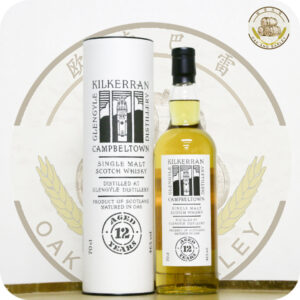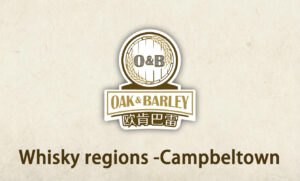


Once a thriving malt whisky region, Campbeltown has a special place in the history of Scottish whisky. One of five areas categorised as a distinct malt whisky producer, along with the Lowlands, the Highlands, Islay, and Speyside, Campbeltown is famous for once having over 30 distilleries, each producing a unique, characterful single malt whisky. Today, only three distilleries remain in this remote settlement. Despite their scarcity, these distilleries serve as dutiful reminders of Campbeltown’s illustrious past, while also cementing the location as a solid contender in modern whisky production.
Campbeltown’s focus on producing high-quality whiskies lead to the region’s enduring fame throughout much of the 1800s, with many of its distinct whiskies remaining highly praised into the early 20th century.
However, a catastrophic series of events led to Campbeltown’s drastic decline. A shifting focus to quantity over quality and the demand for a lighter, less pungent flavour led to Campbeltown’s style falling out of favour with blenders. Whisky consumption also declined as a result of the First World War, and the post-war downturn further affected the economy of the region.
By the end of the 1920s, only one of Campbeltown’s 34 distilleries remained open. With the reopening of Springbank and Glen Scotia in 1934, this final distillery ceased production too.
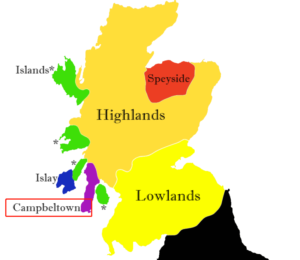



It may be the smallest of Scotland’s whisky regions today, but Campbeltown used to be the whisky capital of the world, with more than 30 distilleries in the town. Today there are just three distilleries remaining, Springbank, Glen Scotia and Glengyle’s Kilkerran. They’re a small band, but these surviving distilleries are still big players in the whisky world, producing some of Scotland’s best malts. And because of the town’s history and the unique characteristics of the malts, Campbeltown is classified as one of Scotland’s official whisky regions alongside Islay, Speyside, Highlands and the Lowlands.
Campbeltown became a whisky boomtown in the 1800s. All the ingredients were there for the whisky industry, including the fertile fields of Kintyre for barley, peat bogs to supply peat for the malting process, the waters of the nearby Crosshill Loch and coal from Drumlemble mine near Machrihanish to fuel the stills. Most importantly, perhaps, was the natural deep sea harbour. Campbeltown was a bustling port and as Campbeltown’s whisky industry grew, steam took the whisky to the fast-growing markets of Glasgow and on to London and America. By the late 1800s, Campbeltown was a prosperous, flourishing town. Check out the villas on the east side of Campbeltown Bay and you’ll get a taste of the wealth that whisky (and herring) brought to the town.
But it wasn’t to last. Seventeen distilleries closed in the 1920s and, by the end of the decade, only Rieclachan was still distilling. By 1934, Springbank and Glen Scotia had restarted production – but Rieclachan had shut for good. What were the reasons? The demand for the region’s whisky was so great that the distilleries couldn’t keep up and quality began to fall. Speyside became connected to the newly-built railways in the north of Scotland allowing it to boost production. World Wars, prohibition and the Great Depression in America all contributed to Campbeltown’s decline.
Nowadays, Springbank, Glen Scotia and Glengyle’s Kilkerran produce whisky with unique characteristics. Campbeltown whiskies are bold. Peat provides the smokiness, while there are strong maritime notes. Experts talk of a whiff of the sea on the nose and a salty, briny flavour on the palate. Springbank malts are probably the most robust, while Glen Scotia malts are lighter with grassy notes. Glengyle’s Kilkerran malts are lighter and sweeter, but with the distinctive oily and salty notes you’d expect from a Campbeltown whisky.
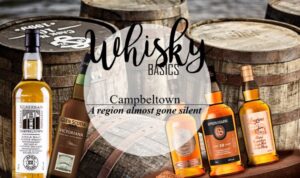


 Although Campbeltown is Scotland’s smallest whisky-producing region, consisting of just three distilleries (in its heyday there were more than 30), its single malts boast unique characteristics that are considered by serious malt lovers to represent a distinct region in its own right. The distilleries that survive today produce some of the finest malts you’re likely to find; they have a devoted following and are much loved worldwide.
Although Campbeltown is Scotland’s smallest whisky-producing region, consisting of just three distilleries (in its heyday there were more than 30), its single malts boast unique characteristics that are considered by serious malt lovers to represent a distinct region in its own right. The distilleries that survive today produce some of the finest malts you’re likely to find; they have a devoted following and are much loved worldwide.

1832, Glen Scotia is one of the smallest whisky distilleries in Scotland. The distillery still maintains much of its original design, including the fermenters, the stillroom and the dunnage warehouse dating from the 1830s. You can choose from a number of tours. Relax in the Victorian-styled shop, learning about the history of Glen Scotia while enjoying a few drams.
Take a wander around Campbeltown and you’ll get an insight into the town’s booming whisky past. Tantalising glimpses remain, from faded signs to old buildings. You’ll also find some cracking whisky bars. The Ardsheil Hotel Whisky Bar is a real treat for whisky lovers, with over 700 malts to choose from. The Hotel won the Wee Dram Whisky Bar of the Year 2010 and the prestigious Scottish Field Whisky Bar of the Year in 2013 and 2014. Or how about popping into Cadenhead’s Whisky Shop and Tasting Room for a fine selection of single malts. And while you’re wandering, you might just find yourself humming along to this Scottish folk song that plays homage to Campbeltown’s whisky:
Oh! Campbeltown Loch, Ah wish ye were whisky!
Campbeltown Loch, Och Aye! Campbeltown Loch, I wish ye were whisky!
Ah wid drink ye dry.
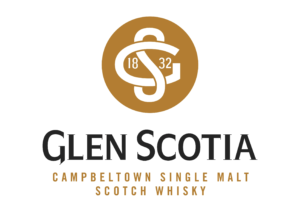
The Production Process:
Small Batch Process: Using only malted barley sourced from the east of Scotland, the process of distilling Glen Scotia single malt Scotch whisky is known as small batch processing. The result is a fine selection of single malt whiskies that are gaining a new following worldwide.
The process known as ‘small batch process’ involves the malted barley first being placed in the Mash Tun where two consecutive waters are added over a period of 8 hours. The first water is added at 66 degrees and the second at 72 degrees.
The Wort, as it is known, is placed in the Washbacks at 22 degrees where yeast is added. The Wort remains in the Washbacks for upwards of 70 hours before being moved to the Wash Still for the initial distillation. The first stage distillation lasts for around 9 hours.
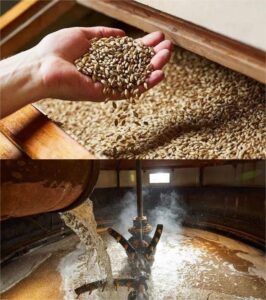
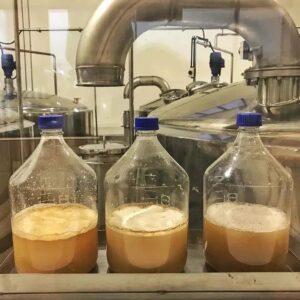 The liquid will be taken off from the Wash Still at around 20% ABV The second distillation in the Spirits Still starts around 20 minutes later when the foreshorts are taken off at 74% ABV and this runs down until 71% ABV. At this point we start to take off the pure spirit. This continues all the way down until the spirits reaches 63% ABV. The average spirit strength at this point is 69% ABV. A little water is added and the whisky enters the casks at 63.5% ABV, the casks are then delivered and laid down in the Dunnage warehouse to be aged by the magic of the wood and the unique Campbeltown weather.
The liquid will be taken off from the Wash Still at around 20% ABV The second distillation in the Spirits Still starts around 20 minutes later when the foreshorts are taken off at 74% ABV and this runs down until 71% ABV. At this point we start to take off the pure spirit. This continues all the way down until the spirits reaches 63% ABV. The average spirit strength at this point is 69% ABV. A little water is added and the whisky enters the casks at 63.5% ABV, the casks are then delivered and laid down in the Dunnage warehouse to be aged by the magic of the wood and the unique Campbeltown weather.
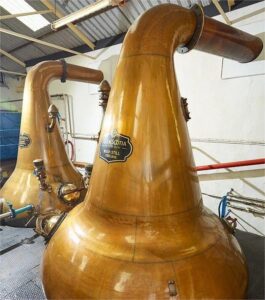
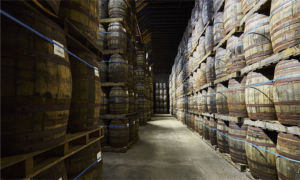 Recommended whiskies:
Recommended whiskies:
Glen Scotia 15 Year Old:An exceptional single malt whisky matured from specially selected casks that deliver the true character of a 15 year old Campbeltown single malt scotch. Matured in the finest American oak barrels, this smooth single malt scotch whisky boasts hints of vanilla oak interwoven with the subtle notes of sea spray and spicy aromatic fruits.
Tasting Notes:
Nose: Richer colours with an intriguingly complex aroma. Broad and medium-weight with citrus peels and ginger snap biscuits. Sweet and with great depth. Apricot aromas develop then drift towards fruit salad. After a short time, the wood comes to the fore and water helps to release baked fruit.
Taste: A complicated palate where the initial nose would lead you to expect plump fruits, but what you get is a surprisingly dry element reminiscent of ginger and cinnamon. Adding water will bring out the caramelised elements, balanced with the wood flavours expected of a good 15 year old whisky.
Finish: Firm and slightly dry with warm spice, honey-like smoothness, and an injection of oak.
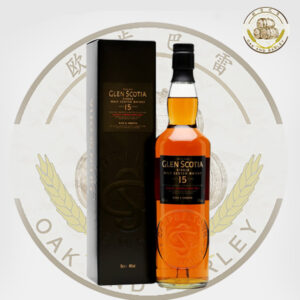 (Click on the picture for details)
(Click on the picture for details)


The Springbank Distillery is a family-owned single malt whisky distillery located on the Kintyre Peninsula on Scotland’s west coast. It established on the site of Archibald Mitchell’s illicit still in 1828. It is one of the last surviving distilleries in Campbeltown, a place that once housed more 30 distilleries.
In 1591, Campbeltown was first associated with whisky in official records. By 1601, it became a popular whisky smuggling centre as well as the place to produce illegal whisky. The Mitchell family (founders of Springbank) moved to Campbeltown as settlers from the Lowlands with skills as maltsters in 1660s.
Archibald Mitchell became a partner at Rieclachan Distillery in 1825 and was later joined by his brother Hugh Michell. When the laws were eased with the registration of whisky distillery, the Mitchell brothers founded Springbank in 1828. Built on the site of Riechlachan Distillery, Springbank became the 14th licensed distillery in Campbeltown.
The family continued to expand their whisky outreach. In 1834, Archibald’s sister, Mary Mitchell, founded Drumore Distillery. By 1837, Archibald’s sons, John and William Mitchell, took over the distillery. The two brothers worked to expand the family’s whisky business, with William founding Glengyle Distillery in 1872.
The family still owned many of the distilleries today. Currently, the 5th generation of the family is in charge at Springbank. He is the great, great grandson of Archibald.
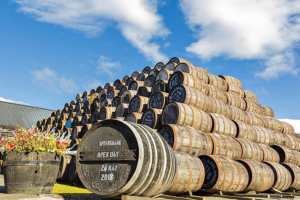 The Production Process:
The Production Process:
The equipment at Springbank is resolutely old-style: an old Boby mill, an open-top cast-iron mash tun, wooden washbacks made from boatskin larch; and three stills, direct fire on one of them, a worm tub on another.
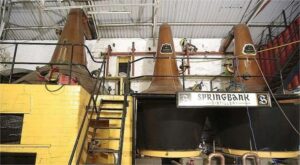 The malt is handled in three ways to produce three contrasting whiskies – Springbank itself is medium-peated, Longrow is heavily peated, while Hazelburn has no peat at all. Ferments are very long – in excess of 100 hours; with low-gravities which both produces a low-strength wash and high levels of esters. This fruity base is then distilled in three different ways, depending on the style being produced.
The malt is handled in three ways to produce three contrasting whiskies – Springbank itself is medium-peated, Longrow is heavily peated, while Hazelburn has no peat at all. Ferments are very long – in excess of 100 hours; with low-gravities which both produces a low-strength wash and high levels of esters. This fruity base is then distilled in three different ways, depending on the style being produced.
Springbank is partially triple-distilled. The wash still (which is direct fired) works as normal producing low wines, the strongest portion of which are directed to the spirit still charger. The remainder is redistilled in the intermediate still (which has a worm tub) and put into the feints receiver along with the heads and tails from the spirit still distillation.
This mix makes up 80% of the final charge, with the strong portion of low wines from the wash still making up the remaining 20%.
Unsurprisingly, the result is a highly complex new make that is collected at an average strength of 71-72% – lightly smoky, oily, fruity, delicately fragrant yet powerful.
Longrow is heavier and smokier – the malted barley obviously playing a significant part, but so does distillation in the direct-fired wash still and second distillation in the spirit still which has the worm tub. It is collected at 68%, lower than Springbank.
Hazelburn undergoes standard triple distillation and is collected at between 74-76% abv.
Maturation for all three is in a mix of casks – as well as the standard ex-Bourbon, ex-Sherry and refill, other types [wine and rum] and sizes [60 litre ‘rundlets’ and 50 litre ‘kilderkins’] are used.
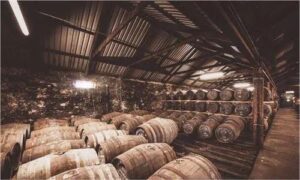 Recommended whiskies:
Recommended whiskies:
Springbank 10:A fabulous 10 year old Springbank, matured in bourbon casks as well as sherry casks, adding a wonderful depth of flavour. Slightly peated, it marries a complex mixture of maritime notes as well as a fresh and fruity balance. The definition of a Campbeltown classic.
Tasting Notes:
Nose: The nose offers up plenty of oak, exotic spices, guava, heather honey and soft smoke.
Palate: A full, sweet, creamy palate with hints of smoke, marzipan and cigar boxes.
Finish: A smoky finish, trailing off on sweet cider and toasty barley.
 (Click on the picture for details)
(Click on the picture for details)


Glengyle distillery is a distillery, founded in 1872 by William Mitchell and completed in 1873. Mitchell had previously been involved with Springbank Distillery but following a quarrel with his brother John, with whom he owned Springbank, he first joined his other brothers at Reichlachan distillery before venturing out on his own. In 1919 the distillery was sold as a result of the post-war economic downturn which was badly affecting all the distilleries in the Campbeltown Region. In 1924 the distillery changed hands again and by 1925 had ceased production with all remaining stock being sold off.
After being used as a rifle range, an attempt to reopen the distillery by Maurice Bloch, who, with his brother, also owned the Glen Scotia distillery, failed due to Second World War as did a second attempt by Campbell Henderson Ltd. in the 1950s. In late 2000 the company of Mitchell’s Glengyle Ltd. was formed with the express purpose of renovating and rebuilding the Glengyle distillery. Mitchell’s Glengyle is associated with the Springbank Distillery, and both operations come under the guidance of Mr. Hedley Wright, a descendant of the Mitchell Family, the original owners of both businesses.
Over the next four years the buildings were repaired to an adequate standard, being restored in line with the local area and the buildings’ listed status (protected by law). Since the original distillery equipment had been disposed of in the 1920s, new stills, malt mills, a mash tun and washbacks were installed along with all the related equipment. In reality much of this was not new, coming instead from other distilleries which had either ceased production or had surplus equipment. Production at the new Glengyle distillery began in 2004.
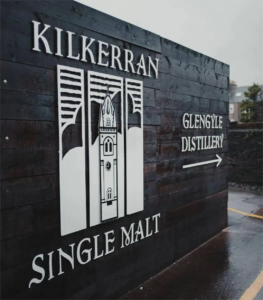 The Production Process:
The Production Process:
The Mashing : The old malting floors of Glengyle Distillery have not been recommissioned yet. Until that day Kilkerran the malt is provided by the sister distillery, Springbank. There, the barley is steeped in water from Cross Hill Loch and then spread on the malting floor for 5-7 days to start the germination process. It is turned over every four hours. After that, the malt is dried over peat fire for 6 hours and over hot air from a gas oven for 30 hours. The malt then has a phenol content of 12-15 ppm. The malt is transported to Glengyle Distillery and milled in a Bobby Mill, a present from Craigellachie Distillery, which had purchased a new mill. Mashing takes place in a semi-lauter mash tun manufactured by Forsyths of Rothes. During mashing, which takes 7-8 hours, in each run four tons of grist are washed out with hot water three times.
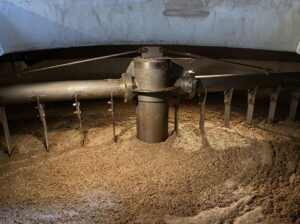 The Fermentation:The resulting wort is then brought to fermentation in the four wash backs made of larch wood with the help of yeast. The containers each have a capacity of 30,000 litres but are only filled with 25,000 litres of wort to leave enough space for active, expanding liquid. After 70 to 110 hours the beer with an alcohol content of 5% abv is ready. The Glengyle website makes it clear that there would be room for additional wash backs.
The Fermentation:The resulting wort is then brought to fermentation in the four wash backs made of larch wood with the help of yeast. The containers each have a capacity of 30,000 litres but are only filled with 25,000 litres of wort to leave enough space for active, expanding liquid. After 70 to 110 hours the beer with an alcohol content of 5% abv is ready. The Glengyle website makes it clear that there would be room for additional wash backs.
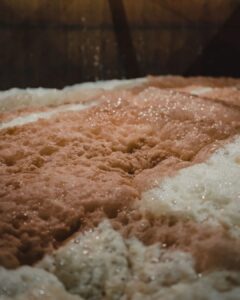 The Distillation : Glengyle took over the distillation equipment from Ben Wyvis Distillery. The wash still holds 18,000 litres, while the spirit still holds 15,000 litres. The latter used to be a wash still, too, but was converted here at Glengyle Distillery. The first distillation run results in 21-23% abv, while the heart of the second distillation run is collected in the spirit receiver with 68% abv.
The Distillation : Glengyle took over the distillation equipment from Ben Wyvis Distillery. The wash still holds 18,000 litres, while the spirit still holds 15,000 litres. The latter used to be a wash still, too, but was converted here at Glengyle Distillery. The first distillation run results in 21-23% abv, while the heart of the second distillation run is collected in the spirit receiver with 68% abv.
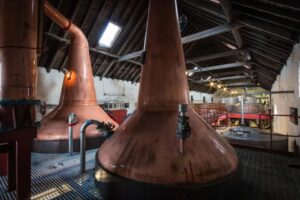 The Storage : The casks are filled with new make that has been diluted to 63.5% abv. with water from Crosshill Loch. The casks are weighed before and after filling in order to measure the exact amount of alcohol filled in. Glengyle uses mainly Bourbon and Sherry casks, but occasionally also port, Madeira or Rum casks. When the casks have been filled and labelled, they are transported by tractors to the warehouses of Springbank Distillery. There are six traditional earthen-floored dunnage warehouses in which the casks are only stored three rows high, but also two racked warehouses with steel racks that house seven rows of casks.
The Storage : The casks are filled with new make that has been diluted to 63.5% abv. with water from Crosshill Loch. The casks are weighed before and after filling in order to measure the exact amount of alcohol filled in. Glengyle uses mainly Bourbon and Sherry casks, but occasionally also port, Madeira or Rum casks. When the casks have been filled and labelled, they are transported by tractors to the warehouses of Springbank Distillery. There are six traditional earthen-floored dunnage warehouses in which the casks are only stored three rows high, but also two racked warehouses with steel racks that house seven rows of casks.
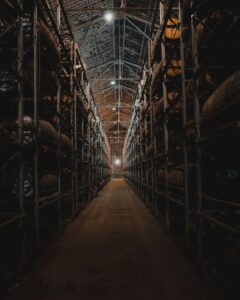 Recommended whiskies:
Recommended whiskies:
Kilkerran 12 Single Malt:After 12 years and a bundle of Work In Progress bottlings, the first core release of single malt Scotch whisky from the Glengyle Distillery after reopening in 2004 is ready! The Kilkerran 12 Year Old is lightly peated and non-chill filtered, and has been matured in a combination of 70% bourbon casks and 30% Sherry casks.
Tasting Notes:
Nose: Oak notes are dominant, followed by toasted marshmallows and dried fruit pudding, as well as cherries, marzipan and a hint of peat.
Palate: Initially fruity with citrus notes and orange peel, after this: vanilla, butterscotch, honeycomb and digestive biscuits can all be tasted and enjoyed.
Finish: Velvet and smooth with lemon meringue, to conclude, there’s an oiliness and a saltiness that you’d expect from a Campbeltown dram.
(Click on the picture for details)




